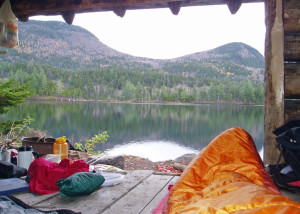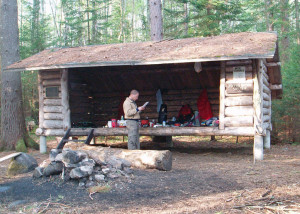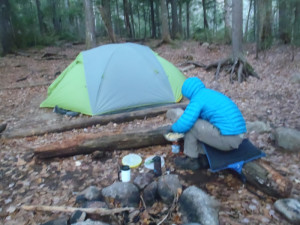
Established Wilderness Campsites in Mud Season
Mud season is a great time to dust the cobwebs off your gear and head out for a shakedown overnight expedition. Or a longer trek if you have the time . . .
Yes, the hiking trails are likely to be a bit muddy at this time of year, and, if you hike properly and stay in the treadway of the trail, walking through puddles and not around them, your feet are going to get wet. Bring extra socks.
During mud season, the woods are as quiet as they’ll ever be. This is an especially great time to explore some of the more popular hiking and camping spots around New England without the crowds. From the first of March until Memorial Day, you can pretty much have it all to yourself, especially mid-week. Even weekends are amazingly quiet in most places
All along the Appalachian Trail from Georgia to Maine, for example, mud season is quiet time. In the deep south, the thru-hikers are moving north, but up here in New England most hikers haven’t ventured out yet. The Same is true on the Long Trail that runs the length of Vermont. The state parks in New York and Connecticut get really crowded in the summer, but not in the spring.

And across the Green Mountain National Forest in Vermont and White Mountain National Forest in New Hampshire, this is the quiet time. Many of the gravel roads are gated for mud season. Lots of these roads have primitive campsites along them. In the summer these places are crowded, but at this time of year you can hike in on the roads and not see another soul. These are perfect for folks who aren’t up for a long hike with a backpack so early in the season and ideal for testing out new equipment before you head out on an extended expedition later on.
Along the more popular hiking trails in the Whites and the Greens, there are established, hike-in campsites, usually with tent pads (compacted, flattened ground), tent platforms (raised wooden platforms you can pitch a tent on) and/or lean-to style shelters. In the summer, these places get lots of visitors. At this time of year, not so many.
Established sites away from the roads are especially nice at this time of year. With an established campsite, you don’t have to go looking for a place to pitch your tent. No matter how muddy the trail is getting there, most campsites will have either compacted tent pads that dry quickly as soon as the snow goes, or raised wooden tent platforms that keep you up out of the mud.

Many also have lean-to shelters which are very convenient, especially if it’s raining. Setting up a tent in the rain isn’t much fun but ducking into a dry lean-to and listening to the rain on the roof sure is . . .
I’m big on privacy, basically don’t like to camp near other people if I can help it, so I tend to gravitate toward the most remote sites where other people are less likely to show up. So even if my destination has a lean-to shelter, I always carry a small, freestanding tent with me so I don’t have to share the lean-to with others. That happens so rarely, I’m not quite sure why I bother with the tent.
If you’ve been cooped up in your house all winter, getting out and about in the spring is a wonderful thing. You don’t have to wait for summer (when the bugs are out) to go camping.
Established Wilderness Campsite Solitude: The One Exception
While most of New England’s trails and shelters are quiet at this time of year, there’s one very notable exception. In the spring, Tuckerman Ravine draws skiers and snowboarders from across the northeast, sometimes more than 1,000 a day.
An awful lot of those folks stay in the lean-tos or on the tent platforms at Hermit Lake in the White Mountains National Forest just below Tuckerman. If you’re looking for peace, quiet and solitude in March, April, or May, it’s best to look somewhere else.
Established Wilderness Campsite Downsides
Of course there are always disadvantages to anything, and established wilderness campsites are no exception.
Though most established sites will have at least one fire ring where campfires are permitted, wood is usually in short supply nearby. Plan on hiking some distance to find dead, down, dry firewood. Cutting live trees is a huge no-no.
Finally, more people mean more food scraps left around and that means critters. I’m especially wary of bears near established campsites, but, truth be told, raccoons, skunks and, especially, mice are more likely to be a problem.
Tents For Established Wilderness Campsites

A couple of things to keep in mind about tents at established wilderness campsites:
1) If you are planning on camping where there are wooden tent platforms, a free-standing tent (one that doesn’t need stakes to hold it up) is MUCH easier to pitch.
2) Wooden platforms and gravel pads are very rough on the nylon floor of your tent. Use a groundcloth underneath your tent to protect the floor
Last year I picked up a near-ideal freestanding tent for this kind of camping situation. It’s called the Quarter Dome from REI, comes in one, two and three person configurations (the one-person is really small but incredibly light—perfect as a backup), and by today’s tent standards, it’s very high quality at a low price. Two things I really like about it: First, it has an optional “footprint” that serves as a groundcloth, protecting the tent floor. Second, with that footprint, you can set up just the fly without the tent which is great for saving weight when there aren’t any bugs around.
Finding Established Wilderness Campsites

Here are some websites that can guide you toward a campsite:
Green Mountain National Forest



I would imagine it still all snow in The White Mountains right now and for some time. I used to go on my birthday during the 1st week of May and more than once I wished I had snow shoes while I was post holing!
John,
You’re right, winter can easily hang on in the Whites until early June! The Presidentials, especially, are a world of their own. There, it always pays to prepare for the worst conditions imaginable–and be ready to retreat if they get worse than that.
Can you tell me where ‘The View’ picture was taken? Looks familiar, but I can’t recall. Thanks.
Chris,
Since shelters are public I can tell you that this one is at Sawyer Pond on the White Mountain National Forest. Busy place in summer, not so much in spring and fall, especially weekdays.